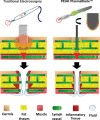Preventive Effect on Seroma of Use of PEAK PlasmaBlade after Latissimus Dorsi Breast Reconstruction
- PMID: 30656116
- PMCID: PMC6326609
- DOI: 10.1097/GOX.0000000000002035
Preventive Effect on Seroma of Use of PEAK PlasmaBlade after Latissimus Dorsi Breast Reconstruction
Abstract
Postoperative seroma is still the main complication after a latissimus dorsi (LD) flap procedure. The etiology of seroma is currently thought to comprise tissue fluids resulting from inflammatory reactions in affected tissue caused by the use of monopolar electrocautery (EC). It is possible that seroma formation can be reduced by using alternative devices such as the PEAK PlasmaBlade (PPB), which provides atraumatic scalpel-like cutting precision while the blade temperature remains close to body temperature. The subjects were 44 patients who underwent breast reconstruction with LD flaps from August 2015 to April 2017. They were retrospectively split into groups treated with a PPB (n = 21) and with conventional EC (n = 23). Outcomes such as rate of seroma formation, total drain discharge volume, indwelling period of drainage at the donor site, length of hospital stay, and operation time were compared between the 2 groups. The incidence of seroma was significantly lower in the PPB group (19.0%) than in the EC group (47.8%). The total drain discharge volume was significantly lower and the indwelling period of drainage and length of hospital stay were significantly shorter in the PPB group. In summary, use of PPB in an LD flap procedure can reduce seroma formation and the lengths of the drainage period and the hospital stay.
Figures


Similar articles
-
Preventive effects on seroma formation with use of the harmonic focus shears after breast reconstruction with the latissimus dorsi flap.J Plast Surg Hand Surg. 2016 Dec;50(6):349-353. doi: 10.1080/2000656X.2016.1178129. Epub 2016 May 5. J Plast Surg Hand Surg. 2016. PMID: 27146859
-
Usefulness of the LigaSure™ small jaw sealing device for breast reconstruction with a latissimus dorsi flap.J Plast Surg Hand Surg. 2019 Oct;53(5):295-300. doi: 10.1080/2000656X.2019.1612753. Epub 2019 May 7. J Plast Surg Hand Surg. 2019. PMID: 31062994
-
Comparison of morbidity-related seroma formation following conventional latissimus dorsi flap versus muscle-sparing latissimus dorsi flap breast reconstruction.Ann Surg Treat Res. 2017 Sep;93(3):119-124. doi: 10.4174/astr.2017.93.3.119. Epub 2017 Aug 30. Ann Surg Treat Res. 2017. PMID: 28932726 Free PMC article.
-
The use of OK-432 to prevent seroma in extended latissimus dorsi flap donor site after breast reconstruction.J Surg Res. 2015 Jan;193(1):492-6. doi: 10.1016/j.jss.2014.08.010. Epub 2014 Aug 12. J Surg Res. 2015. PMID: 25201573
-
Pulsed Electron Avalanche Knife (PEAK) PlasmaBlade versus Traditional Electrocautery for Surgery: A Review of Clinical Effectiveness and Cost-Effectiveness [Internet].Ottawa (ON): Canadian Agency for Drugs and Technologies in Health; 2019 Aug 9. Ottawa (ON): Canadian Agency for Drugs and Technologies in Health; 2019 Aug 9. PMID: 31693325 Free Books & Documents. Review.
Cited by
-
Comparative Study of Mastectomy Surgical Techniques Followed by Reconstruction: Hydrodissection and Electrical Plasma Surgery.J Clin Med. 2025 Feb 18;14(4):1338. doi: 10.3390/jcm14041338. J Clin Med. 2025. PMID: 40004868 Free PMC article.
-
Successful use of electrosurgery in an occipitocervical fusion procedure in a patient with an established cochlear implant: illustrative case.J Neurosurg Case Lessons. 2025 Aug 11;10(6):CASE25167. doi: 10.3171/CASE25167. Print 2025 Aug 11. J Neurosurg Case Lessons. 2025. PMID: 40789217 Free PMC article.
-
Bilateral reduction mammaplasty with pulsed electron avalanche knife PlasmaBlade™ and conventional electrosurgical surgery: A retrospective, randomised controlled clinical trial.Int Wound J. 2020 Dec;17(6):1695-1701. doi: 10.1111/iwj.13452. Epub 2020 Jul 9. Int Wound J. 2020. PMID: 32644304 Free PMC article. Clinical Trial.
-
A Retrospective Study of Coronary Artery Bypass Grafting with Low-Thermal Plasma Dissection Device Compared to Conventional Monopolar Electrosurgery.Braz J Cardiovasc Surg. 2021 Jun 1;36(3):379-387. doi: 10.21470/1678-9741-2020-0386. Braz J Cardiovasc Surg. 2021. PMID: 34236794 Free PMC article. Clinical Trial.
-
PlasmaBlade versus Electrocautery for Deep Inferior Epigastric Perforator Flap Harvesting in Autologous Breast Reconstruction: A Comparative Clinical Outcome Study.J Clin Med. 2024 Apr 19;13(8):2388. doi: 10.3390/jcm13082388. J Clin Med. 2024. PMID: 38673669 Free PMC article.
References
-
- Schwabegger A, Ninković M, Brenner E, et al. Seroma as a common donor site morbidity after harvesting the latissimus dorsi flap: observations on cause and prevention. Ann Plast Surg. 1997;38:594. - PubMed
-
- Sowa Y, Numajiri T, Kawarazaki A, et al. Preventive effects on seroma formation with use of the harmonic focus shears after breast reconstruction with the latissimus dorsi flap. J Plast Surg Hand Surg. 2016;50:349. - PubMed
-
- Woodworth PA, McBoyle MF, Helmer SD, et al. Seroma formation after breast cancer surgery: incidence and predicting factors. Am Surg. 2000;66:444; discussion 450. - PubMed
-
- McCaul JA, Aslaam A, Spooner RJ, et al. Aetiology of seroma formation in patients undergoing surgery for breast cancer. Breast. 2000;9:144. - PubMed
Grants and funding
LinkOut - more resources
Full Text Sources
Research Materials
Miscellaneous
